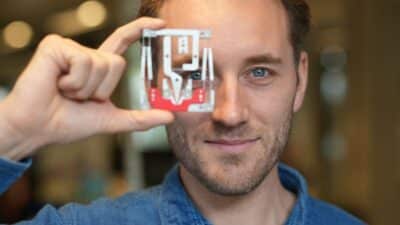For Nobleo Technology, precision and innovation go hand in hand. Designer Rik Houwers recently deepened his expertise through the ‘Thermal Effects in Mechatronic Systems’ course, gaining new insights into how temperature fluctuations influence high-precision machines and how modelling in the frequency domain can lead to smarter, more stable designs.
“Building something you design yourself is always fun,” Rik Houwers, designer at Nobleo says, “because you get direct feedback. Unfortunately, that is not always possible.” He studied mechanical engineering at Delft University of Technology, specializing in biomechanics and precision mechanics. He was introduced to Nobleo, where he has now worked for nine years. His work consists mainly of mechanical design and analysis of mechatronic systems and metrology machines.
Due to the multidisciplinary nature of mechatronics, the team is essential. “We work with experts from different fields: mechanical, electronical, control, software, purchasing and sometimes thermal or optical. Understanding the basics of each other’s disciplines, allows effective communication and that makes all the difference. Moreover, the best innovative ideas often are found at the border of multiple disciplines.”
'With this tool in my toolkit, I have even more options to develop creative and smart designs for our customers.'
A high impact niche
Houwers recently attended the course ‘Thermal Effects in Mechatronic Systems‘ offered by Mechatronics Academy through High Tech Institute. During an earlier project, he had seen firsthand how temperature variations can impact measurement accuracy. “In the machine I was working on, thermal disturbances turned out to be the dominant cause of deviations in the measurements. Since then, I’ve wanted to understand those mechanisms better.”
Nobleo’s technical director Frank Sperling had already pointed Houwers to courses at High Tech Institute before. Houwers has previously taken courses such as ‘Passive Damping for High Tech Systems’ and ‘Applied Optics’. The knowledge from both of these courses could already be applied in customer projects. According to him, this new training fits perfectly alongside them. “With this tool in my toolkit, I have even more options to develop creative and smart designs for our customers.”

Houwers shows a flexure mechanism, a test sample containing viscous damping rubber that was aimed at damping away problematic vibrations
The training is recommended for mechatronic designers who focus on high-precision applications. “As soon as you design for accuracies better than tens of micrometers, you usually can’t ignore thermal effects.” According to Houwers, this is fairly precise in the field, but no exception. “For reference, machines at ASML need to achieve nanometer-level precision.”
The course matched well with his background in dynamics. “The level was just right. The instructors, including Theo Ruijl of MI-Partners, explained the theory clearly and always linked it to real industrial examples.”
Understanding thermal effects
The three-day course offered a clear structure. The first day focused on the basics of heat transfer and thermal physics. Day two was about temperature measurement and practical examples, and the third day addressed temperature control in systems. “Thermal systems seem simpler than dynamic systems because they don’t have resonances,” Houwers explains. “But if you tune the controller incorrectly, you can still get an instable system. With a few simple design rules you can prevent that.”
The pace was high and not all assignments could be fully completed in the time available, but that did not bother Houwers. After all, the goal of the course was to absorb as much knowledge as possible in three days and that was delivered.
Although he doesn’t have a direct application for the knowledge he has gained, Houwers sees clear value in it. “At Nobleo, we are constantly working on cutting-edge systems. Sooner or later, those thermal questions will come up. When they do, it’s great to really understand the physics behind them.”
'The most valuable insight I gained from the course came from the frequency-domain to thermal problems. This insight is remarkably powerful for us.'
Thinking in frequencies
The most valuable insight that Houwers gained from the course came from the frequency-domain approach to thermal problems. “Temperature fluctuations each have their own frequency. The day-night cycle changes slowly, the air conditioning might switch on and off every half hour, and people walking by cause air displacements that vary over minutes.”
How strongly these variations affect the accuracy of a machine depends on the process frequency and how quickly the different components react to temperature changes. Heavy, massive components, for example, heat up more slowly than lighter parts, and materials with low thermal conductivity cause heating to occur slow and non-uniform. As a result, certain frequency heating often result in a non-synchronised warming, where one part expands, while the other is still cold. This causes deformation and measurement deviations. By modelling the system in the frequency domain, engineers gain insight into which temperature disturbances matter for the required precision.
According to Houwers, this way of thinking is remarkably powerful. “You can predict how heat spreads through a machine, how quickly parts respond and how that affects positioning. This guides design choices in material, construction, and control strategy.”
At Nobleo Technology, everything revolves around high-tech innovation in the broadest sense. The Eindhoven-based company operates in four complementary domains: Autonomous Systems, Intelligence, Embedded & Electronics and Mechatronic Systems. The first focuses on autonomous vehicles and robots, while Intelligence develops smart algorithms, for example for image recognition and quality control. Embedded & Electronics supports the development of intelligent systems by designing and integrating hardware, electronics and embedded software that enable precise control and smart decision-making. Within the Systems branch, the emphasis is on precision, speed and predictable systems for the industry, from complex chip machines to fruit sorting machines. In that regard the training fits very well with Houwers’ career path in mechatronics at Nobleo.
This article is written by Marleen Dolman, freelancer for High Tech Systems.

